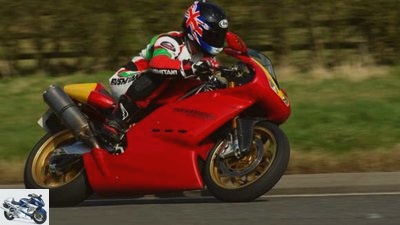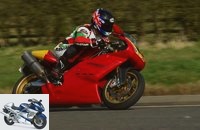Menus

Koyichi Nakamura
Driving report Ducati Supermono Strada (2009)
Ducati Supermono Strada
What the Italians couldn’t or didn’t want in the nineties is now – who else – builds an Englishman. Namely the street version of the legendary Ducati Supermono racer.
Supermono Modern
The Ducati, which was built from 1993 to 1995 in only 67 copies, is not only popular among hardcore fans S.upermono as the most elaborate and well thought-out single-cylinder racer that has ever been released in small series on the slopes of the world. The single, whose captivating silhouette was the first work of Pierre Terblanche, who was later heavily scolded for the 999, was born out of necessity.
Buy complete article

Driving report
Ducati Supermono Strada
Koyichi Nakamura
While the silhouette corresponds to the original, the technology is state-of-the-art.
Mounted in a Ducati-typical tubular space frame and equipped with the best suspension and brake components, the package worked so well that the Supermono not only dominated the single-cylinder classes, but could easily keep up with the 600cc four-cylinder models, at least on angular courses. The horizontal cylinder made the motorcycle quite long, but the weighty cylinder head moved down to make it easy to handle, which at least concealed the lack of performance.
Despite all the successes, the single-cylinder fan base, which was very large in the nineties, failed to have its greatest wish: a supermono street offshoot for the people. Ducati did not see the commercial success of a single, especially since it would have been quite expensive. So the fans only had to pray, hope, wait – and save. Today, after a good 15 years of hope, one can say: the wait was worth it, the prayers were answered – and saving was necessary.
Koyichi Nakamura
Alistair Wager, Ducati-Intimus and 2001 team boss of the Ducati-AMA-Superbike-Team is the builder of the new Supermono.
Alistair Wager made the dream come true. He’s the kind of person whose motivation increases in inverse proportion to the feasibility of a project. In addition, he personally worked on no fewer than 20 of the 67 models built and headed the Ducati Superbike team in the USA in 2001. Competence and affinity for the topic were there.
Also excellent contacts to the factory, because he succeeded in procuring some of the extremely rare sand-cast motor housings as well as other super mono-specific parts such as the auxiliary connecting rod. The frame is made in England from fine chrome-molybdenum steel tubing as a 1: 1 copy of the original.
Most of the other components come from the Ducati kit. The 999 R donated not only the cylinder and the Testastretta head, but also the 54 millimeter throttle valve including injection. The 999 donated triple clamps, electronics, side stands and cockpits as well. The six-speed gearbox comes from the 800 SS, the starter and electronics originally belonged to a 916, the water cooler and the headlights to a 749. Even the 1098R was not spared, it was allowed to use the famous Monobloc – Contribute brake calipers.
There is even a Japanese component on the Supermono Strada – a sacrilege for purists: the coolant expansion tank comes from the Yamaha R6. But even purists should be conciliatory when looking at the fairing, which has not been changed except for the headlight cutouts. The exquisitely crafted carbon landscape is a masterpiece of contemporary design and comes from the supplier who is the only one outside of Japan with a license to manufacture official Honda HRC parts.
Koyichi Nakamura
At this waistline, every wasp will get jealous.
So equipped, ready to drive, but with an empty 14-liter tank, 134 kilograms (that’s only six kilograms more than the original racer despite the street garb) on 88 horsepower measured on the crankshaft. As long as the throttle valve is only opened at a small angle, a well-muffled sound of single escapes from the right-hand exhaust instead of the left-hand exhaust as in the original. The stew doesn’t really like under 4000 tours and shakes vigorously.
The vibrations dwindle with increasing speed, from 5000 it inflates the jaws to become really toxic from 6200. At 9800 the performance peak is reached, at 10200 the limiter intervenes. In this area, the noise emissions are no longer compatible with the health resort. The golden mean lies between 6000 and 8000 tours. The seating position is quite stretched due to the long wheelbase, but not overly cramped despite the high footrests. Just old racing style.
The old virtues of the supermono are still effective today: Very stable on the brakes and handy when bending and turning, you make up for the time you lose on the straights against the strong multi-cylinders in the winding curve. Hardly anyone will fight this seriously, because a price of 34,800 pounds (38,700 euros) makes you cautious. Nevertheless, Alistair Wager has already received three orders…
Technical specifications
Koyichi Nakamura
In contrast to the original, the Strada has the exhaust on the right.
Ducati Supermono Strada
engine
Water-cooled single-cylinder four-stroke engine, two overhead, toothed belt driven camshafts, four valves per cylinder, injection, Ø 54 mm, hydraulically operated multi-disc dry clutch, six-speed gearbox, chain.
Bore x stroke 104 x 70 mm
Cubic capacity 595 cm³
Rated output 64.7 kW (88 hp) at 9800 rpm
Max. Torque k. A..
landing gear
Steel tubular frame, load-bearing motor, upside-down fork, Ø 43 mm, adjustable spring base, compression and rebound damping, two-arm swing arm made of aluminum, central spring strut, directly hinged, adjustable spring base, compression and rebound damping, double disc brake at the front, Ø 305 mm, four-piston Fixed calipers, radially mounted, rear disc brake, Ø 200 mm, two-piston fixed caliper.
Forged magnesium wheels 3.50 x 17; 5.50 x 17
Tires 120 / 60-17; 180 / 55-17
Dimensions + weights
Wheelbase 1420 mm, seat height k. A., weight ready to drive without petrol 134 kg, tank capacity 14 liters.
Price approx. 38 700 euros
Ducati Supermono Racer
Koyichi Nakamura
Not for highway use: The supermono was built exclusively for racing.
It came, saw, won and disappeared: right from the very first outing for the Italian championship, the single-cylinder engine that had been consistently developed for the racetrack drove the competition around the ears. Many more wins and titles followed. The Supermono was built in two batches at prices from 45,000 marks (approx. 22,500 euros). In 1993 there were 43 units with 549 cc and around 75 hp, in 1995 another 26 units with 572 cc and 81 hp. An originally planned road branch was never realized. Well-preserved supermonos have the status of a blue Mauritius and are traded accordingly.
Related articles
-
Driving report Ducati Monster 821 (2014)
Photo: Ducati 18th photos Ducati 1/18 The Ducati Monster 821 combines the rudimentary tubular space frame with the small Testastretta with 821 cm³, which…
-
Driving report Ducati MH 900 evoluzione
Driving report Ducati MH 900 evoluzione Pop meets classic So new and yet so old: The Ducati MHe ?? a tribute to the successful British racing driver Mike…
-
Ducati Driving report Ducati GT 1000 The first and the last Inspired by the past: the GT 1000 bows to the first production Duc with a V2 engine, the GT…
-
Ducati 1199 Panigale R in the driving report
Manufacturer 32 photos Ducati 1/32 Ducati 1199 Panigale R.. Ducati 2/32 Ducati 1199 Panigale R.. Ducati 3/32 Ducati 1199 Panigale R.. Ducati 4/32 Ducati…
-
Ducati Monster 821 driving report
Ducati 25th photos Ducati 1/25 The 1200s had already indicated in which direction the monster train rolls: water cooling and motor as load-bearing…
-
Driving report Aprilia RSV mille R “Haga”, Ducati 998 S “Bostrom ??
Driving report Aprilia RSV mille R “Haga”, Ducati 998 S “Bostrom ?? Pop stars Rare, sinfully expensive and hovering between art and kitsch: Aprilia and…
-
Driving report Ducati Monster 1000 S
Driving report Ducati Monster 1000 S Halloween party It doesn’t take pumpkin ghosts and ghost costumes to celebrate Halloween. The Ducati Monster 1000 S…
-
Driving report: Ducati Monster 796
fact 10 photos Ducati 1/10 Iom 78: On the Isle of Man (IOM), Mike Hailwood wrote another chapter in Ducati history in 1978: he came, saw and won in…
-
Ducati Scrambler Cafe Racer driving report
Ducati 20th photos Ducati 1/20 Ducati Scrambler Cafe Racer Ducati 2/20 Ducati Scrambler Cafe Racer Ducati 3/20 Historical quotations everywhere. The…
-
Ducati 1299 Superleggera driving report
Ducati 35 photos Ducati 1/35 Ducati 1299 Superleggera. Ducati 2/35 Ducati 1299 Superleggera. Ducati 3/35 At the zenith of its power, the Superquadro unit…